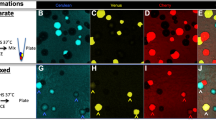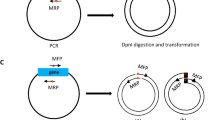Abstract
DNA-mediated transformation is one of the most widely used techniques to study gene function. The eukaryote Dictyostelium discoideum is amenable to numerous genetic manipulations that require insertion of foreign DNA into cells. Here we describe two commonly used methods to transform Dictyostelium cells: calcium phosphate precipitation, resulting in high copy number transformants; and electroporation, an effective technique for producing single integration events into genomic DNA. Single integrations are required for gene disruption by homologous recombination. We also discuss how different selection markers affect vector copy number in transformants and explain why blasticidin has become the preferred selectable marker for making gene knockouts. Both procedures can be accomplished in less than 2 h of hands-on time; however, the calcium phosphate precipitation method contains several incubations, including one of at least 4 h, so the total time required for the transformation is approximately 8 h.
This is a preview of subscription content, access via your institution
Access options
Subscribe to this journal
Receive 12 print issues and online access
$259.00 per year
only $21.58 per issue
Buy this article
- Purchase on Springer Link
- Instant access to full article PDF
Prices may be subject to local taxes which are calculated during checkout
Similar content being viewed by others
References
Manstein, D.J., Titus, M.A., De Lozanne, A. & Spudich, J.A. Gene replacement in Dictyostelium: generation of myosin null mutants. EMBO J. 8, 923–932 (1989).
Simon, M.N., Driscoll, D., Mutzel, R., Part, D., Williams, J. & Veron, M. Overproduction of the regulatory subunit of the cAMP-dependent protein kinase blocks the differentiation of Dictyostelium discoideum . EMBO J. 8, 2039–2043 (1989).
Crowley, T.E., Nellen, W., Gomer, R.H. & Firtel, R.A. Phenocopy of discoidin I-minus mutants by antisense transformation in Dictyostelium . Cell 43, 633–641 (1985).
Martens, H., Novotny, J., Oberstrass, J., Steck, T.L., Postlethwait, P. & Nellen, W. RNAi in Dictyostelium: the role of RNA-directed RNA polymerases and double-stranded RNase. Mol. Biol. Cell 13, 445–453 (2002).
Kuspa, A. Restriction enzyme-mediated integration (REMI) mutagenesis. Methods Mol. Biol. 346, 201–209 (2006).
Nellen, W., Silan, C. & Firtel, R.A. DNA-mediated transformation in Dictyostelium discoideum: regulated expression of an actin gene fusion. Mol. Cell. Biol. 4, 2890–2898 (1984).
Howard, P.K., Ahern, K.G. & Firtel, R.A. Establishment of a transient expression system for Dictyostelium discoideum . Nucleic Acids Res. 16, 2613–2623 (1988).
Pang, K.M., Lynes, M.A. & Knecht, D.A. Variables controlling the expression level of exogenous genes in Dictyostelium . Plasmid 41, 187–197 (1999).
Lloyd, M.M., Ceccarelli, A. & Williams, J.G. Establishment of conditions for the transformation of nonaxenic Dictyostelium strains. Dev. Genet. 11, 391–395 (1990).
Wetterauer, B., Salger, K., Demel, P. & Koop, H. Efficient transformation of Dictyostelium discoideum with a particle inflow gun. Biochim. Biophys. Acta 1499, 139–143 (2000).
Sutoh, K. A transformation vector for Dictyostelium discoideum with a new selectable marker bsr. Plasmid 30, 150–154 (1993).
Egelhoff, T.T., Brown, S.S., Manstein, D.J. & Spudich, J.A. Hygromycin resistance as a selectable marker in Dictyostelium discoideum . Mol. Cell. Biol. 9, 1965–1968 (1989).
Chang, A.C., Hall, R.M. & Williams, K.L. Bleomycin resistance as a selectable marker for transformation of the eukaryote, Dictyostelium discoideum . Gene 107, 165–170 (1991).
Leiting, B. & Noegel, A.A. The ble gene of Streptoalloteichus hindustanus as a new selectable marker for Dictyostelium discoideum confers resistance to phleomycin. Biochem. Biophys. Res. Commun. 180, 1403–1407 (1991).
Chang, A.C., Williams, K.L., Williams, J.G. & Ceccarelli, A. Complementation of a Dictyostelium discoideum thymidylate synthase mutation with the mouse gene provides a new selectable marker for transformation. Nucleic Acids Res. 17, 3655–3661 (1989).
Kalpaxis, D., Werner, H., Boy-Marcotte, E., Jacquet, M. & Dingermann, T. Positive selection for Dictyostelium mutants lacking uridine monophosphate synthase activity based on resistance to 5-fluoro-orotic acid. Dev. Genet. 11, 396–402 (1990).
Morio, T., Adachi, H., Sutoh, K., Yanagisawa, K. & Tanaka, Y. Bsr-REMI: an improved method for gene tagging using a new vector in Dictyostelium . J. Plant Res. 108, 111–114 (1995).
Barth, C., Fraser, D.J. & Fisher, P.R. Co-insertional replication is responsible for tandem multimer formation during plasmid integration into the Dictyostelium genome. Plasmid 39, 141–153 (1998).
Early, A.E. & Williams, J.G. Two vectors which facilitate gene manipulation and a simplified transformation procedure for Dictyostelium discoideum . Gene 59, 99–106 (1987).
Fey, P., Kowal, A.S., Gaudet, P., Pilcher, K.E. & Chisholm, R.L. Protocols for growth and development of Dictyostelium discoideum . Nat. Protoc. 2, 1307–1316 (2007).
Sussman, R. & Sussman, M. Cultivation of Dictyostelium discoideum in axenic medium. Biochem. Biophys. Res. Commun. 29, 53–55 (1967).
Watts, D.J. & Ashworth, J.M. Growth of myxameobae of the cellular slime mould Dictyostelium discoideum in axenic culture. Biochem. J. 119, 171–174 (1970).
Wetterauer, B. et al. Wild-type strains of Dictyostelium discoideum can be transformed using a novel selection cassette driven by the promoter of the ribosomal V18 gene. Plasmid 36, 169–181 (1996).
Caterina, M.J., Milne, J.L. & Devreotes, P.N. Mutation of the third intracellular loop of the cAMP receptor, cAR1, of Dictyostelium yields mutants impaired in multiple signaling pathways. J. Biol. Chem. 269, 1523–1532 (1994).
Hadwiger, J.A. & Firtel, R.A. Analysis of G alpha 4, a G-protein subunit required for multicellular development in Dictyostelium . Genes Dev. 6, 38–49 (1992).
Kalpaxis, D. et al. Positive selection for Dictyostelium discoideum mutants lacking UMP synthase activity based on resistance to 5-fluoroorotic acid. Mol. Gen. Genet. 225, 492–500 (1991).
Faix, J., Kreppel, L., Shaulsky, G., Schleicher, M. & Kimmel, A.R. A rapid and efficient method to generate multiple gene disruptions in Dictyostelium discoideum using a single selectable marker and the Cre-loxP system. Nucleic Acids Res. 32, e143 (2004).
Betapudi, V., Shoebotham, K. & Egelhoff, T.T. Generation of double gene disruptions in Dictyostelium discoideum using a single antibiotic marker selection. Biotechniques 36, 106–112 (2004).
Insall, R.H., Soede, R.D., Schaap, P. & Devreotes, P.N. Two cAMP receptors activate common signaling pathways in Dictyostelium . Mol. Biol. Cell 5, 703–711 (1994).
Alibaud, L., Cosson, P. & Benghezal, M. Dictyostelium discoideum transformation by oscillating electric field electroporation. Biotechniques 35, 78–80, 82–83 (2003).
Shah-Mahoney, N., Hampton, T., Vidaver, R. & Ratner, D. Blocking the ends of transforming DNA enhances gene targeting in Dictyostelium . Gene 203, 33–41 (1997).
Morrison, A., Marschalek, R., Dingermann, T. & Harwood, A.J. A novel, negative selectable marker for gene disruption in Dictyostelium . Gene 202, 171–176 (1997).
Sambrook, J., Fritsch, E.F. & Maniatis, T. (eds.) Molecular Cloning: A Laboratory Manual (Cold Spring Harbor Laboratory, Cold Spring Harbor, NY, 1989).
Tuxworth, R.I., Cheetham, J.L., Machesky, L.M., Spiegelmann, G.B., Weeks, G. & Insall, R.H. Dictyostelium RasG is required for normal motility and cytokinesis, but not growth. J. Cell Biol. 138, 605–614 (1997).
Jordan, M., Schallhorn, A. & Wurm, F.M. Free in PMC transfecting mammalian cells: optimization of critical parameters affecting calcium-phosphate precipitate formation. Nucleic Acids Res. 24, 596–601 (1996).
Loyter, A., Scangos, G.A. & Ruddle, F.H. Mechanisms of DNA uptake by mammalian cells: fate of exogenously added DNA monitored by the use of fluorescent dyes. Proc. Natl. Acad. Sci. USA 79, 422–426 (1982).
Acknowledgements
dictyBase (http://www.dictybase.org) is supported by grants from the NIH (GM64426 and HG00022).
Author information
Authors and Affiliations
Corresponding author
Ethics declarations
Competing interests
The authors declare no competing financial interests.
Rights and permissions
About this article
Cite this article
Gaudet, P., Pilcher, K., Fey, P. et al. Transformation of Dictyostelium discoideum with plasmid DNA. Nat Protoc 2, 1317–1324 (2007). https://doi.org/10.1038/nprot.2007.179
Published:
Issue Date:
DOI: https://doi.org/10.1038/nprot.2007.179
This article is cited by
-
CRISPR/Cas9 mediated targeting of multiple genes in Dictyostelium
Scientific Reports (2018)
-
Red fluorescent cAMP indicator with increased affinity and expanded dynamic range
Scientific Reports (2018)
-
Pumilio-dependent localization of mRNAs at the cell front coordinates multiple pathways required for chemotaxis
Nature Communications (2017)
-
Reliable handling of highly A/T-rich genomic DNA for efficient generation of knockin strains of Dictyostelium discoideum
BMC Biotechnology (2016)
-
Caspase-like proteins: Acanthamoeba castellanii metacaspase and Dictyostelium discoideum paracaspase, what are their functions?
Journal of Biosciences (2014)
Comments
By submitting a comment you agree to abide by our Terms and Community Guidelines. If you find something abusive or that does not comply with our terms or guidelines please flag it as inappropriate.



